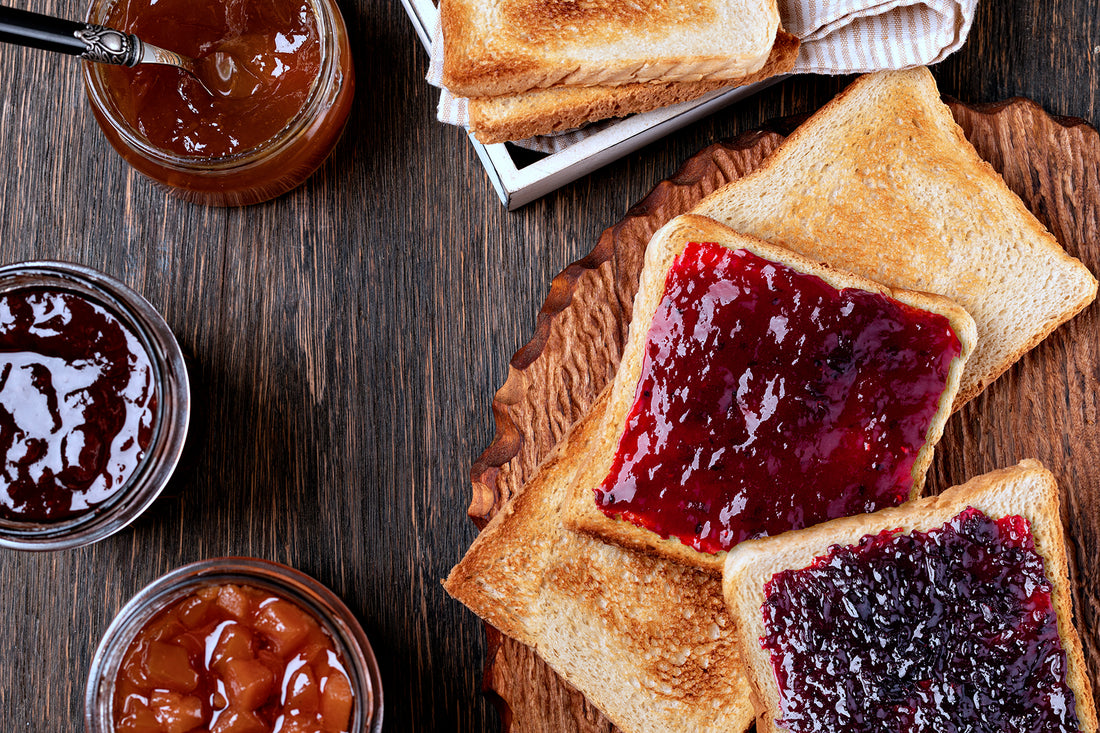
Marmellata o Confettura e Composta : Quali sono le differenze?
Share

La marmellata è composta esclusivamente da agrumi, come l'arancia, il pompelmo, il mandarino, il cedro e il bergamotto, mentre la confettura può essere preparata con qualsiasi tipo di frutta.
La storia della confettura e della marmellata: dalle antiche tradizioni ai giorni nostri
La storia della marmellata e della confettura è antica e affascinante. Le prime testimonianze risalgono all'antica Roma, dove già si preparavano conserve di frutta a base di miele o zucchero, destinate a durare a lungo. Ma è soprattutto in Inghilterra che la marmellata diventa un prodotto di largo consumo: si narra infatti che nel 1480 la regina Maria Tudor rimase colpita dal sapore di una conserva a base di mele e zucchero, e ne ordinò immediatamente la produzione in grande quantità. Da allora, la marmellata divenne un prodotto molto diffuso in Gran Bretagna, e successivamente in tutto il mondo.
La confettura, invece, ha origini francesi. Il termine deriva infatti dal francese "confire", che significa "conservare". Inizialmente si preparava con la polpa di frutta cotta insieme a una grande quantità di zucchero, e la sua consistenza era molto densa e zuccherina. Con il passare del tempo, la
Differenza tra Marmellata e Confettura di Frutta
La differenza tra marmellata e confettura di frutta risiede proprio nella loro composizione. Mentre la marmellata è composta solo da agrumi, la confettura può essere preparata con qualsiasi tipo di frutta. Inoltre, la percentuale di frutta utilizzata della marmellata deve essere del 20%, mentre nella confettura può essere inferiore.
Confettura di Frutta
Con la frutta viene invece chiamata confettura, che può essere preparata con qualsiasi tipo di frutta. La confettura viene spesso consigliata per fare conserve, in quanto la percentuale di zuccheri utilizzati provengono esclusivamente dalla frutta, garantendo un conseguente minor apporto calorico.
La percentuale di frutta nella preparazione di marmellate e confetture
Un aspetto fondamentale che determina la qualità del prodotto finale. Secondo la direttiva europea, per poter essere definita marmellata, la
Le confetture e marmellate extra: caratteristiche e differenze
Le confetture e marmellate extra sono caratterizzate dalla presenza di una percentuale di frutta superiore rispetto alle comuni. Infatti, la normativa europea prevede che le confetture extra debbano contenere almeno il 35% di frutta, mentre le marmellate extra devono contenere almeno il 45% di frutta. Queste percentuali sono significativamente superiori rispetto ai prodotti industriali , che spesso contengono percentuali di frutta molto più basse.
Le confetture e marmellate extra, grazie alla maggiore quantità di frutta, presentano una consistenza più densa e una maggiore intensità di sapore. Inoltre, sono spesso prive di additivi chimici e conservanti, il che le rende una scelta più salutare rispetto alle industriali.
Richiede un maggiore impegno e una maggiore attenzione alla qualità della frutta utilizzata. Inoltre, la maggiore quantità di frutta può comportare un costo più elevato rispetto a un prodotto indrustiale
Direttiva Europea sulla Marmellata e la Confettura
Agrumi utilizzati per la Marmellata
Come abbiamo detto, la marmellata è composta esclusivamente da agrumi. Gli agrumi utilizzati per la
- Arancia
- Pompelmo
- Mandarino
- Cedro
- Bergamotto
Preparazione della Confettura
La preparazione di una buona confettura richiede molta esperienza e conoscenza delle proprietà della frutta e degli ingredienti utilizzati. È importante scegliere la giusta quantità di zucchero e limone in base alla frutta utilizzata e alla consistenza desiderata. Inoltre, è possibile aggiungere altri ingredienti come spezie, erbe aromatiche o liquori per arricchire il gusto e creare nuovi abbinamenti di sapori.
La degustazione di una buona confettura richiede un palato allenato per apprezzare la giusta consistenza, il giusto equilibrio tra dolce e acido e la presenza di eventuali ingredienti aggiunti. Una buona confettura deve avere un sapore intenso e naturale della frutta utilizzata, senza l'aggiunta di conservanti o coloranti artificiali.
Quali sono le confetture e marmellate migliori da abbinare ai formaggi, al pesce, alla carne o al pane per la colazione
Le confetture e marmellate sono spesso associate alla colazione, ma possono essere utilizzate anche in cucina per dare un tocco di dolcezza ai piatti salati. In particolare, alcune varietà si sposano perfettamente con determinati tipi di cibo.
Per quanto riguarda i formaggi, le confetture di frutta con una consistenza morbida e una dolcezza non troppo invadente, come la confettura di fichi o di pere, sono le più adatte per un abbinamento perfetto. Inoltre, la marmellata di arance amare si sposa alla perfezione con formaggi stagionati dal sapore deciso
Per il pesce, invece, le confetture di agrumi come il limone, l'arancia o il bergamotto sono perfette per insaporire piatti a base di pesce azzurro o crostacei. In particolare, la confettura di cipolle rosse o di cipolle bianche si sposa bene con il salmone affumicato.
Per quanto riguarda la carne, invece, le confetture di frutta rossa come la confettura di prugne o di ciliegie sono ottime per insaporire piatti a base di carni rosse. Inoltre, la marmellata di arance o di mandarino si sposa bene con carni bianche come il pollo o la tacchino.
Infine, per la colazione, le confetture di frutta mista o di frutti di bosco sono le più comuni e versatili. La confettura di fragole o di mirtilli si sposa bene con il pane tostato, mentre la confettura di albicocche o di pesche si abbina perfettamente alle fette biscottate.
In generale, è importante scegliere una confettura o marmellata di qualità, con una percentuale elevata di frutta e senza l'aggiunta di coloranti o conservanti. In questo modo, si avrà un prodotto dal sapore autentico e genuino, perfetto per abbinarsi ai cibi in modo equilibrato e armonioso.
Coloranti: cosa sono e perché vengono utilizzati nelle confetture e marmellate industriali
I coloranti sono sostanze utilizzate nell'industria alimentare per dare colore ai prodotti, tra cui le confetture e marmellate. La scelta di utilizzare coloranti deriva principalmente dalla necessità di uniformare il colore dei prodotti e renderli più appetibili per i consumatori. Tuttavia, l'uso di coloranti può comportare alcuni rischi per la salute, soprattutto quando vengono utilizzati in dosi elevate o in combinazione con altri additivi.
In particolare, i coloranti sintetici possono contenere sostanze potenzialmente nocive come metalli pesanti, solventi chimici e composti organici volatili. L'ingestione di questi composti può comportare problemi di salute come allergie, intolleranze alimentari, disturbi gastrointestinali e persino malattie gravi come il cancro. Per questo motivo, la Commissione Europea ha stabilito dei limiti precisi per l'uso di coloranti nelle confetture e marmellate industriali, al fine di garantire la sicurezza alimentare dei consumatori.
Per evitare i rischi derivanti dall'uso di coloranti sintetici, è possibile optare per le confetture e marmellate naturali, preparate senza l'aggiunta di sostanze chimiche o additivi artificiali. In questo modo si può assicurare una maggior qualità del prodotto, con un gusto autentico e genuino, e allo stesso tempo tutelare la propria salute.
Precauzioni per la tua salute
Nella produzione industriale di marmellate e confetture vengono spesso utilizzati coloranti, conservanti e additivi come l'acido citrico e ascorbico. Questi ingredienti possono essere dannosi per la tua salute se assunti in grandi quantità. In questo paragrafo ti spieghiamo i rischi dell'utilizzo di questi ingredienti e come evitarli.
Precauzioni per la tua salute
Nella produzione industriale di marmellate e confetture vengono spesso utilizzati coloranti, conservanti e additivi come l'acido citrico e ascorbico. Questi ingredienti possono essere dannosi per la tua salute se assunti in grandi quantità. In questo paragrafo ti spieghiamo i rischi dell'utilizzo di questi ingredienti e come evitarli.

